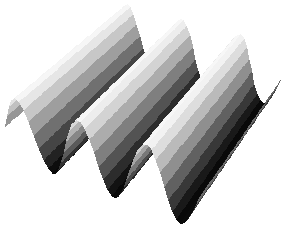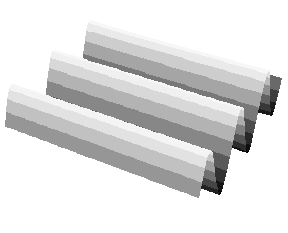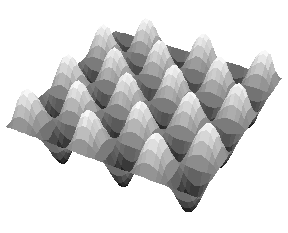Why does a Microwave Oven have Hot Spots?
 So when we did the experiment with marshmallows in a microwave
oven I could see that the "hot" and "cold" spots made a regular pattern, but I don't
understand why it's kind of like a checkerboard. If it was just the crests and troughs of the
waves causing the hot spots, I would have thought the pattern would look like this:
So when we did the experiment with marshmallows in a microwave
oven I could see that the "hot" and "cold" spots made a regular pattern, but I don't
understand why it's kind of like a checkerboard. If it was just the crests and troughs of the
waves causing the hot spots, I would have thought the pattern would look like this:
|

|
 Well, that is what it would look like if the waves were only coming from one
direction, but that's not how microwaves work. If the wave you imagined was moving from side
to side in the microwave, there is also a wave going front to back, like this:
Well, that is what it would look like if the waves were only coming from one
direction, but that's not how microwaves work. If the wave you imagined was moving from side
to side in the microwave, there is also a wave going front to back, like this:
|

|
 Oh, and now we have to combine the two waves, like we had to in the
Two Slit Experiment, except here we have to
add two whole surfaces, not just two lines...
Oh, and now we have to combine the two waves, like we had to in the
Two Slit Experiment, except here we have to
add two whole surfaces, not just two lines...
 Exactly. It's a little harder to visualize, but its the same kind of thing. The result looks like this:
Exactly. It's a little harder to visualize, but its the same kind of thing. The result looks like this:

 Cool! The high and low areas in that picture match the pattern we saw in the marshmallow
experiment. But wait a second, I have two problems with this. First, if the waves are moving
at the speed of light, shouldn't the hot spots be moving, too? Also, does this mean that all
microwave ovens have TWO "microwave guns"? I mean, one for the back and forth waves and one
for the front to back waves?
Cool! The high and low areas in that picture match the pattern we saw in the marshmallow
experiment. But wait a second, I have two problems with this. First, if the waves are moving
at the speed of light, shouldn't the hot spots be moving, too? Also, does this mean that all
microwave ovens have TWO "microwave guns"? I mean, one for the back and forth waves and one
for the front to back waves?
 Not only are those both good questions, but they have the same answer. The "microwave guns"
are called "magnetrons" and a microwave oven only has one of them. We get two different wave
patterns because the physics of a microwave oven leads to something called Standing Waves...
Not only are those both good questions, but they have the same answer. The "microwave guns"
are called "magnetrons" and a microwave oven only has one of them. We get two different wave
patterns because the physics of a microwave oven leads to something called Standing Waves...






